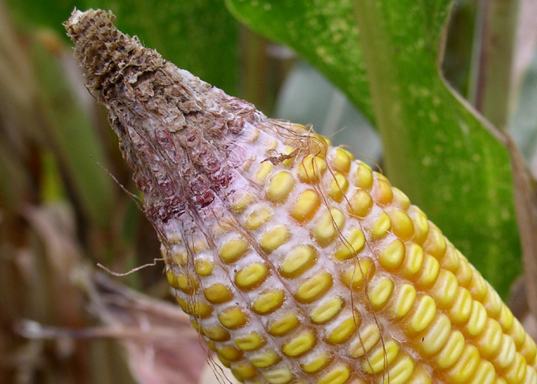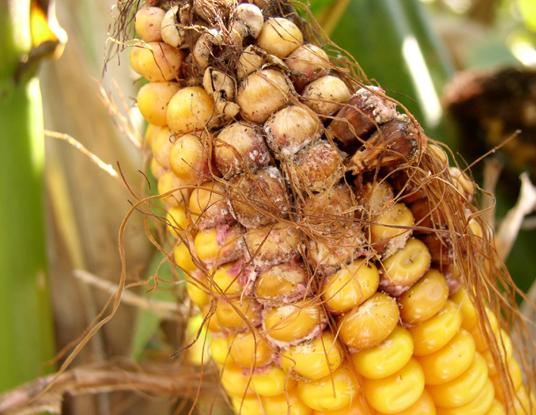Disease Facts
- Caused by the fungus Gibberella zeae.
- Overwinters in infected crop residue.
- Spores are spread from residue to corn ears by wind and rain.
- Infection of corn ears occurs through young silks.
- Infection favored by cool, wet weather during and after pollination (optimum temperature 65 to 70 °F).
- Often a problem in the northern and eastern Corn Belt (both US and Canada).
- Most common in continuous corn or corn following wheat that was infected with Fusarium head blight.

Disease Symptoms
- Most readily identified by the red or pink color of the mold starting at ear tip.
- Mold may be very pale in some cases, causing it to be confused with other ear rots.
- Gibberella almost always begins at the ear tip and progresses from there.
- Fusarium is usually scattered throughout the ear or localized on injured kernels.
- Diplodia usually starts at the base of the ear, is gray rather than pink, and husks may be “bleached.”
- Early, severely infected ears may rot completely, with husks adhering tightly to the ear and the mold growing between the husks and ear.
- Perithecia, or black fungal fruiting structures, may be lightly attached to kernel surface.
Mycotoxins
- Gibberella zeae can produce two mycotoxins in the infected kernels: deoxynivalenol and zearalenone.
- These mycotoxins can be harmful to many monogastric animals, especially swine.
- Mycotoxin contamination of grain may or may not accompany ear mold symptoms.

Management
- Scout fields before harvest in order to make informed
decisions about harvest timing, postharvest grain handling, storage and utilization.
- Fields with significant infestations of Gibberella ear rot should be harvested as early as possible and handled separately.
- Set combine to reduce kernel damage and remove fines and shriveled or broken kernels.
- Dry infected grain at high temperature to a moisture of 15% or less and monitor grain in storage to maintain its condition.
- Test grain for presence of mycotoxins and manage accordingly.
The foregoing is provided for informational use only. Please contact your Pioneer sales professional for information and suggestions specific to your operation. Product performance is variable and depends on many factors such as moisture and heat stress, soil type, management practices and environmental stress as well as disease and pest pressures. Individual results may vary. CF200904

